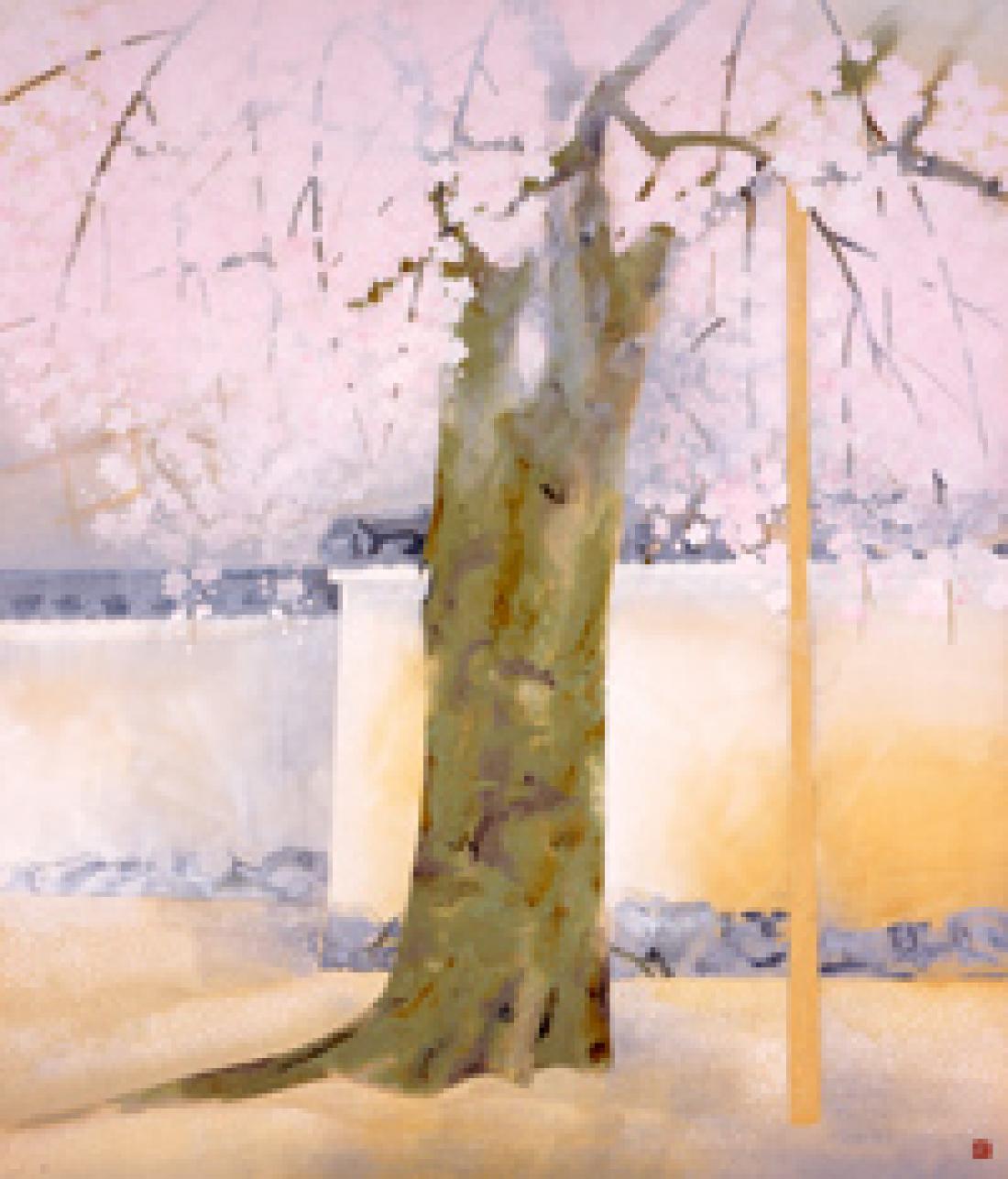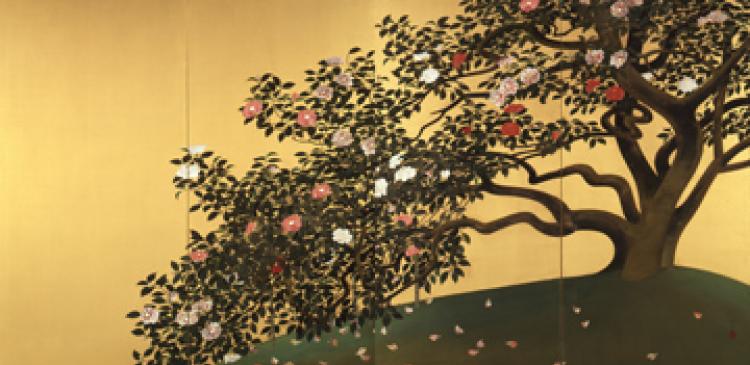Dogyu Okumura, Cherry Blossoms at Daigo-ji Temple, 1972 (owend by Yamatane Museum of Art)
*This piece is planned to be displayed in “A Profusion of Flowers-Painting the Four Seasons” (April 27 to June 5, 2011, Yamatane Museum of Art) and “The Best of the Yamatane Collection” (2nd rotation: January 3 to February 5, 2012, Yamatane Museum of Art).
By Keiko Sakagami, Professor, Faculty of Letters, Arts and Sciences, Waseda University (School of Culture, Media and Society)
<Before reproducing in any form, please read the copyright notice at the end of this article>
Due to the earthquake, this year many annual events and spectacular exhibitions that are timed to coincide with the blooming cheery blossoms have been cancelled or delayed.
After being reminding of the power of nature, even art you see all the time takes on a different appearance. In particular, nature as presented in traditional Japanese art, which had always seemed to be about the beauty of nature and praising natural vistas, now all seem to be portrayals of nature’s power. However, through this different viewpoint, new revelations occur.
In the Setagaya Art Museum’s current Masako Shirasu exhibition, the Sun Moon Mountain Water Image (Jitsugetsu sansui zu) (owned by Kongoji Temple, Osaka, artist unknown, 16th century) folding screen is being displayed. The nature drawn in this powerfully deformed and designed piece has curves that remind one of art nouveau, and is a piece filled with modern sensibility. But what can be felt from it is not just a sense for decorating, but the terrifying energy nature possesses that has the capacity to move the earth, beyond the comprehension of humanity.
It has been 250 years since the birth of Hokusai (1760-1849). In the past year, there have been many related exhibitions held, but an exhibition from the Honolulu Academy of Arts that was to be displayed in Japan for the first time has unfortunately been delayed due to the earthquake (Mitsui Memorial Museum).
Hokusai often painted large waves. We are used to seeing the Great Wave off Kanagawa, one of Hokusai’s famous 36 Views of Mount Fuji, but viewing it again after the earthquake, the wave cresting in the shape of a hand and about to overcome the small boat and the people inside it, it now seems like a display of the terrifying power of nature itself. At the same time Hokusai’s landscapes often show people as merely a small part of the vastness of nature, quietly eking out a living, which can be felt even more strongly now.
Compared to western art, traditional Japanese art uses nature as a theme far more commonly. We have looked at the design sense and decorative nature of this art, from a modern viewpoint and a comparison to western realism with a focus on people. But now we can understand that it is not simply an issue of art. These past artists who were closer to nature’s power were representing a deeper truth that cannot be explained by simple art theory.
The large waves that Hokusai repeatedly painted seem to be a simple representation of the vast energy of nature that sometimes changes its shape and attacks humanity. Respect and fear, love and hate. Japanese art has likely been founded within the complex emotions that are directed towards nature.
Both Gyoshu Hayami’s Camellia Petals Scattering and Dogyu Okumura’s Cherry Blossoms at Daigo-ji Temple (both the Yamatane Museum of Art) display the life energy of spring, with trees growing powerfully from the earth. These pieces have never looked as splendid as they do this year. A hint to solving our current questions of what nature is, how it should be faced and how to coexist with it should be hidden within these art pieces that have viewed nature.
=====================================
About the Author:
Keiko Sakagami
Professor, Faculty of Letters, Arts and Sciences, Waseda University
(School of Culture, Media and Society)
She graduated from the School of Letters, Arts and Sciences I, Waseda University, majoring in History of Art. After studying at Graduate School of Letters, Arts and Sciences, Waseda University, she has assumed the present post. Her speciality is modern and contemporary art, comparative culture. Her major works include “Painters in Dream and Luminescence: Reconsideration of Modernite (Modernity)” (publisher: Skydoor/ Winning the new face award of Minister of Education Award for Fine Arts) and “Berthe Morisot: Modern Times Lived by a Female Painter” (publisher: Shogakukan Inc.).
======================================
【Copyright Notice】
All of the articles, images, photographs and other content displayed above are owned by Waseda University. Permission to reproduce any content is subject to the following Terms of Use.
Terms of Use
- Content may not be used in a manner that may harm the honor or reputation of Waseda University.
- When reproducing any content, you must request permission by notifying the Office of Information and Public Relations of Waseda University through e-mail ([email protected]) and indicate the title of the media and intended date of reproduction. Unauthorized reproduction is strictly prohibited.
- Please cite clearly the source of content at the end of each article using the following format (Source: ResearchSEA yyyy/mm/dd).
- Content may not be altered or modified in any way. Manipulation of photographs is strictly forbidden. Use of quotations as protected under copyright law is limited to summarization or quotation of the main point.
- Use of content is protected under the copyright law. Any claims or disputes, privacy issues, or other matters related to copyrighted content not owned or controlled by Waseda University becomes the sole responsibility of the user.




